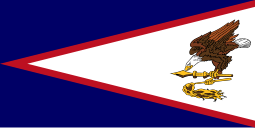Flag of American Samoa
 | |
| Use | Civil and state flag |
|---|---|
| Proportion | 10:19 |
| Adopted | April 27, 1960 |
| Design | A red-edged white triangle pointing towards the hoist charged with a bald eagle clutching a war club and fly-whisk. The upper and lower triangles are dark blue. |
The flag of American Samoa is a flag consisting of a red-edged white triangle pointing towards the hoist charged with a bald eagle clutching a war club and fly-whisk, with dark blue upper and lower triangles. Adopted in April 1960 to replace the "Stars and Stripes" as the official flag of the territory, it has been the flag of the Territory of American Samoa since that year. The colors used epitomize the traditional colors of the United States and Samoa.
History
Before the first Europeans set foot on the islands in the 18th century, Samoa did not use any flags. They first utilized flags during the 1800s, although it is unclear which ones were flown due to partial documentation.[1] The islands were contested by Germany, the United Kingdom and the United States at the turn of the century;[2] the three countries resolved the dispute by dividing Samoa amongst themselves during the Tripartite Convention in 1899.[1][3] As a result, the United States took control over the eastern half of Samoa and raised their flag on April 27, 1900. It went on to be the only official flag of American Samoa until 1960.[1]
In the mid-20th century, Samoans began to take a more active role in the local government. Consequently, deliberations began over a new territorial flag and the Samoans were invited to propose ideas. Local government leaders and the U.S. Army Institute of Heraldry then designed the flag while incorporating these ideas into it. The flag was officially adopted April 27, 1960, sixty years to the day the U.S. first raised the American flag over Samoa.[1]
Design
The colors and symbols of the flag carry cultural, political, and regional meanings. The red, white and blue represent the colors traditionally utilized by both the United States and Samoa.[1] The bald eagle represents the U.S. and features on the flag,[4] although it does not live in American Samoa.[5] It clutches two Samoan symbols, alluding to America's guardianship over American Samoa,[6] as well as evoking the Great Seal of the United States.[7] The symbols are a uatogi (a war club, epitomizing the government's power) and a fue (a fly-whisk, representing the wisdom of traditional Samoan leaders).[1]
See also
References
- ^ a b c d e f Smith, Whitney. "American Samoa, flag of". Encyclopedia Britannica. Encyclopedia Britannica, Inc. Retrieved June 6, 2013. (subscription required)
- ^ "History of Upolu". Lonely Planet. Retrieved June 6, 2013.
- ^ Wise, Benjamin E. (2012). William Alexander Percy: The Curious Life of a Mississippi Planter and Sexual Freethinker. U of North Carolina Press. p. 93. Retrieved June 6, 2013.
- ^ Kindersley, Dorling (November 3, 2008). Complete Flags of the World. Dorling Kindersley Ltd. p. 19. Retrieved June 6, 2013.
- ^ Swanson, Doug J. (September 9, 1990). "Land of the lavalava and CNN – Hybrid culture evolving in American Samoa". The Dallas Morning News. p. 10M. Retrieved June 6, 2013. (subscription required)
- ^ Shaw, Carol P. (2004). Flags. HarperCollins UK. p. 28. Retrieved June 6, 2013.
- ^ "American Samoa". The World Factbook. CIA. Retrieved June 6, 2013.
